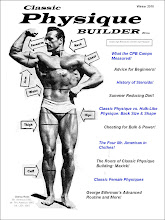
(Above photo: Golden Age Mag - Muscle Builder Magazine, July 54 issue)
Are you a beginner interested in gaining muscular weight? Have you been training for a few months and yet have seen no results? Well, you are not alone. Many in the Golden Age (the 1940s and 50s) experienced the same thing. Here is some classic advice from the Questions and Answers column of Joe Weider's Muscle Builder Magazine (July 1954 issue):
Question: Dear Sir, I've been exercising for 3 1/2 months now and have made good progress, so far as strength and muscularity are concerned. But I've not gained weight. I maintain a good protein diet and still no results. Please advise me on what to do. D.L. Brooklyn. N.Y.
Answer: Donald, you are an example of what the Weider Research Clinic has always taught...Each man is a law unto himself where bodybuilding is concerned. One man will make great gains in bodyweight, but little in strength, during his beginner's peroid in weight training. Another man will get powerful and muscular in his first training months, but make little gains in weight. But these physical qualities gradually reach the point of balance with each other. Progress in power...bulk...muscularity, is made in a series of steps...a little gain, then maybe a slight drop or a leveling off, then a slight gain once more. You appear to have gained first in strength and delineation. I am not too concerned with your failure to gain weight at this present stage of training since you have only been bodybuilding for 3 1/2 months. If you had been weight training for a year without any great bodyweight gains, then I'd say you had something to worry about. My advice to you is this. Cut down slightly on your upper body work such as the various curls, presses and rowing motions. Shorten your routine to the bench press, barbell curl, squat and breathing pullover. Use as heavy a poundage as possible in the squat and alternate each set of squats with a set of breathing pullovers. Rest up completely on your non training days. Get at least eight hours sleep each night and at least 10 hours in bed! Don't hurry. Don't worry...and buy the Weider Gaining Food Supplement.
CPB Commentary: So there you have it - a classic, abbreviated routine to kick start some muscular weight gaining. In a nutshell, here is the routine again:
1. Bench Press
2. Barbell Curls
3. Squats - superset with
4. Breathing Pullovers
Use as much poundage as possible (so that you can barely squeeze out the last rep). Keep pushing the weight up as you get stronger. It wasn't specifed, but fewer sets (e.g., 2-3 sets per exercise) and low reps (e.g., 6-7 reps) were usually recommended for such routines.
Note how important a lot of sleep and rest are as well as not worrying & hurrying. The Weight Gaining Food Supplement that was recommended was really a vitamin B complex supplement that acted as an appetite stimulant.
So if you are having trouble gaining weight, you can give this classic routine from the Golden Age a try! It's worked before and may well work for you! - CPB











